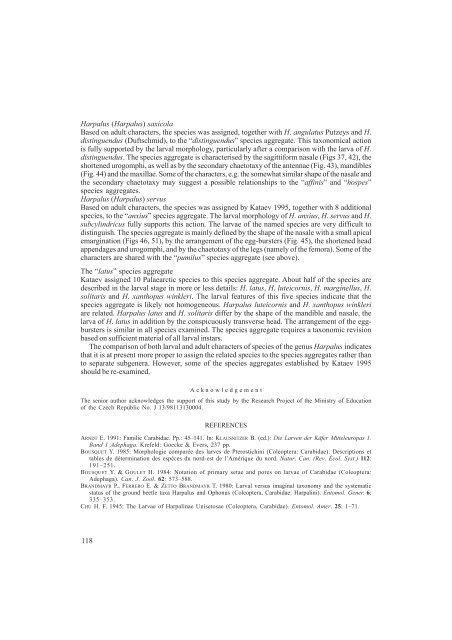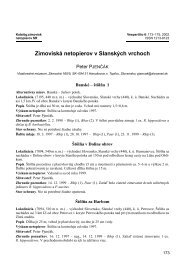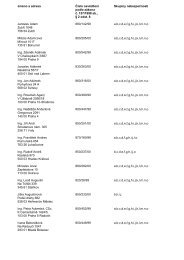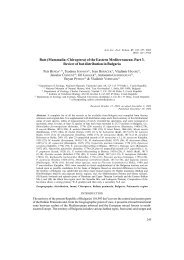Based on <strong>the</strong> study of our larval material, as well as on data <strong>in</strong> <strong>the</strong> literature, <strong>the</strong> genus Harpalus<strong>in</strong> our concept may be characterised ma<strong>in</strong>ly by <strong>the</strong> follow<strong>in</strong>g characters: (1) Nasale deepenedbetween adnasalia; (2) Labial palpomere I <strong>in</strong> both second and third <strong>in</strong>stars with 2 (1–4) short setaenear apex; (3) Mandible with 0–4 teeth <strong>in</strong> front of ret<strong>in</strong>aculum, mandibular apex never bifid; (4)Antennomere II <strong>in</strong> <strong>in</strong>stars II and III with (1)2–5(6) large subapical setae directed <strong>in</strong>wards; (5) Innerside of stipes with a setal group gMX consist<strong>in</strong>g of more than 40 setae.A slightly more than 10 subgenera are mentioned world-wide <strong>in</strong> <strong>the</strong> genus Harpalus <strong>in</strong> ourconcept (Lorenz 1998), several tens of species aggregates are recognised <strong>in</strong> <strong>the</strong> subgenus Harpalus(Kataev 1995). In addition to <strong>the</strong> subgenus Harpalus, some of <strong>the</strong> larval characters areavailable also for species of <strong>the</strong> subgenera Acardystus Reitter, 1908 (Habu 1973), Artabas DesGozis, 1882 (Puchkov 1992), Harpalophonus Ganglbauer, 1892 (Zeto Brandmayr & Brandmayr1978), Megapangus Casey, 1914 (Kirk 1972), Plectralidus Casey, 1914 (Kirk 1972) and SemiophonusSchauberger, 1933 (Hrka 1992). Taxonomic–morphological differences between <strong>the</strong> larvaeof <strong>the</strong> species aggregates of <strong>the</strong> subgenus Harpalus are often more significant than thosebetween <strong>the</strong> larvae of conventional subgenera.The results of our study of both larval and adult characters with<strong>in</strong> <strong>the</strong> subgenus Harpalussensu novo mostly quite support <strong>the</strong> Kataev’s division <strong>in</strong> species aggregates that was establishedus<strong>in</strong>g adult characters, as it can be documented by <strong>the</strong> follow<strong>in</strong>g examples:Harpalus (Harpalus) atratusKataev 1995 established <strong>the</strong> separate species aggregate “atratus” for this species. This is fullysupported by <strong>the</strong> larval characters. Unique is <strong>the</strong> form of nasale (Figs 2, 7), <strong>the</strong> shape of mandiblewith two additional teeth <strong>in</strong> front of ret<strong>in</strong>aculum (Fig. 3), <strong>the</strong> shape of first <strong>in</strong>star labium (Fig. 5), aswell as <strong>the</strong> general habitus of <strong>the</strong> larva.Harpalus (Harpalus) cisteloides hurkaiA separate “cisteloides” species aggregate was established for this and three additional speciesby Kataev 1995. This is fully supported by <strong>the</strong> larval morphology, particularly by <strong>the</strong> follow<strong>in</strong>g:details <strong>in</strong> <strong>the</strong> development of <strong>the</strong> nasale, with <strong>the</strong> wide V–shaped medial emarg<strong>in</strong>ation (Figs 12, 16),<strong>the</strong> development of <strong>the</strong> ancestral chaetotaxy, <strong>the</strong> m<strong>in</strong>ute setae PA2 and PA3, and particularly <strong>the</strong>reduced setae FR8, FR9 and an additional seta near <strong>the</strong>m. Some of <strong>the</strong>se characters are similar tothose of H. autumnalis from <strong>the</strong> next species aggregate, <strong>in</strong> particular <strong>the</strong> similar shape of <strong>the</strong>mandible and of <strong>the</strong> egg–bursters, similar arrangement of <strong>the</strong> additional chaetotaxy of <strong>the</strong> labiumand of <strong>the</strong> legs (particularly of <strong>the</strong> femora), <strong>the</strong> similar development of <strong>the</strong> secondary chaetotaxy of<strong>the</strong> antennae, mandibles and of <strong>the</strong> maxillae. The actual relationships are not clear at present.Harpalus (Harpalus) picipennisA well def<strong>in</strong>ed “pumilus” species aggregate was established for this and seven additional species(= Actephilus Stephens, 1833). This is entirely supported by <strong>the</strong> larval morphology, especiallyafter a comparison with <strong>the</strong> larva of H. pumilus. The larvae of this group are characterised particularlyby <strong>the</strong> shape of <strong>the</strong> nasale (Figs 29, 33), by <strong>the</strong> markedly shortened head appendages, by <strong>the</strong>arrangement of <strong>the</strong> egg-bursters (Fig. 28), and by <strong>the</strong> shortened urogomphi. The shortened headappendages and urogomphi and <strong>the</strong> basic shape of <strong>the</strong> nasale, are similar to those of <strong>the</strong> “anxius”species aggregate, but <strong>in</strong> <strong>the</strong> latter <strong>the</strong> arrangement of <strong>the</strong> egg-bursters, <strong>the</strong> additional chaetotaxyof <strong>the</strong> legs and <strong>the</strong> details <strong>in</strong> <strong>the</strong> shape of <strong>the</strong> nasale are different.117
Harpalus (Harpalus) saxicolaBased on adult characters, <strong>the</strong> species was assigned, toge<strong>the</strong>r with H. angulatus Putzeys and H.dist<strong>in</strong>guendus (Duftschmid), to <strong>the</strong> “dist<strong>in</strong>guendus” species aggregate. This taxonomical actionis fully supported by <strong>the</strong> larval morphology, particularly after a comparison with <strong>the</strong> larva of H.dist<strong>in</strong>guendus. The species aggregate is characterised by <strong>the</strong> sagittiform nasale (Figs 37, 42), <strong>the</strong>shortened urogomphi, as well as by <strong>the</strong> secondary chaetotaxy of <strong>the</strong> antennae (Fig. 43), mandibles(Fig. 44) and <strong>the</strong> maxillae. Some of <strong>the</strong> characters, e.g. <strong>the</strong> somewhat similar shape of <strong>the</strong> nasale and<strong>the</strong> secondary chaetotaxy may suggest a possible relationships to <strong>the</strong> “aff<strong>in</strong>is” and “hospes”species aggregates.Harpalus (Harpalus) servusBased on adult characters, <strong>the</strong> species was assigned by Kataev 1995, toge<strong>the</strong>r with 8 additionalspecies, to <strong>the</strong> “anxius” species aggregate. The larval morphology of H. anxius, H. servus and H.subcyl<strong>in</strong>dricus fully supports this action. The larvae of <strong>the</strong> named species are very difficult todist<strong>in</strong>guish. The species aggregate is ma<strong>in</strong>ly def<strong>in</strong>ed by <strong>the</strong> shape of <strong>the</strong> nasale with a small apicalemarg<strong>in</strong>ation (Figs 46, 51), by <strong>the</strong> arrangement of <strong>the</strong> egg-bursters (Fig. 45), <strong>the</strong> shortened headappendages and urogomphi, and by <strong>the</strong> chaetotaxy of <strong>the</strong> legs (namely of <strong>the</strong> femora). Some of <strong>the</strong>characters are shared with <strong>the</strong> “pumilus” species aggregate (see above).The “latus” species aggregateKataev assigned 10 Palaearctic species to this species aggregate. About half of <strong>the</strong> species aredescribed <strong>in</strong> <strong>the</strong> larval stage <strong>in</strong> more or less details: H. latus, H. luteicornis, H. marg<strong>in</strong>ellus, H.solitaris and H. xanthopus w<strong>in</strong>kleri. The larval features of this five species <strong>in</strong>dicate that <strong>the</strong>species aggregate is likely not homogeneous. Harpalus luteicornis and H. xanthopus w<strong>in</strong>kleriare related. Harpalus latus and H. solitaris differ by <strong>the</strong> shape of <strong>the</strong> mandible and nasale, <strong>the</strong>larva of H. latus <strong>in</strong> addition by <strong>the</strong> conspicuously transverse head. The arrangement of <strong>the</strong> eggburstersis similar <strong>in</strong> all species exam<strong>in</strong>ed. The species aggregate requires a taxonomic revisionbased on sufficient material of all larval <strong>in</strong>stars.The comparison of both larval and adult characters of species of <strong>the</strong> genus Harpalus <strong>in</strong>dicatesthat it is at present more proper to assign <strong>the</strong> related species to <strong>the</strong> species aggregates ra<strong>the</strong>r thanto separate subgenera. However, some of <strong>the</strong> species aggregates established by Kataev 1995should be re-exam<strong>in</strong>ed.A c k n o w l e d g e m e n tThe senior author acknowledges <strong>the</strong> support of this study by <strong>the</strong> Research Project of <strong>the</strong> M<strong>in</strong>istry of Educationof <strong>the</strong> <strong>Czech</strong> <strong>Republic</strong> No. J 13/98113130004.REFERENCESARNDT E. 1991: Familie Carabidae. Pp.: 45–141. In: KLAUSNITZER B. (ed.): Die Larven der Käfer Mitteleuropas 1.Band 1 Adephaga. Krefeld: Goecke & Evers, 237 pp.BOUSQUET Y. 1985: Morphologie comparée des larves de Pterostich<strong>in</strong>i (Coleoptera: Carabidae): Descriptions ettables de déterm<strong>in</strong>ation des espces du nord-est de l’Amérique du nord. Natur. Can. (Rev. Écol. Syst.) 112:191–251.BOUSQUET Y. & GOULET H. 1984: Notation of primary setae and pores on larvae of Carabidae (Coleoptera:Adephaga). Can. J. Zool. 62: 573–588.BRANDMAYR P., FERRERO E. & ZETTO BRANDMAYR T. 1980: Larval versus imag<strong>in</strong>al taxonomy and <strong>the</strong> systematicstatus of <strong>the</strong> ground beetle taxa Harpalus and Ophonus (Coleoptera, Carabidae: Harpal<strong>in</strong>i). Entomol. Gener. 6:335–353.CHU H. F. 1945: The Larvae of Harpal<strong>in</strong>ae Unisetosae (Coleoptera, Carabidae). Entomol. Amer. 25: 1–71.118
- Page 2: Acta Soc. Zool. Bohem. 66: 81-84, 2
- Page 5 and 6: REFERENCESBERAN L. & HORSÁK M. 199
- Page 7: Tab. 1. Nematodes studied with the
- Page 10: Tab. 2. The dimensions (mm) of thir
- Page 14 and 15: Family Acuariidae Railliet, Henry e
- Page 16 and 17: Fig. 7. Cosmocephalus obvelatus (Cr
- Page 18 and 19: A c k n o w l e d g e m e n t sThe
- Page 20 and 21: Acta Soc. Zool. Bohem. 66: 99-119,
- Page 22 and 23: Figs 1-10. Harpalus (Harpalus) atra
- Page 24 and 25: Figs 11-19. Harpalus (Harpalus) cis
- Page 26 and 27: Figs 20-27. Harpalus (Harpalus) lut
- Page 28 and 29: Figs 28-35. Harpalus (Harpalus) pic
- Page 30 and 31: Figs 36-44. Harpalus (Harpalus) sax
- Page 32 and 33: Figs 45-53. Harpalus (Harpalus) ser
- Page 34 and 35: Figs 54-61. Harpalus (Harpalus) sol
- Page 36 and 37: Figs 62-70. Harpalus (Harpalus) xan
- Page 40 and 41: EMDEN F. I. van 1942: A key to the
- Page 42 and 43: Acta Soc. Zool. Bohem. 66: 121-140,
- Page 44 and 45: and D. papillifera (Fuhrmann, 1908)
- Page 46 and 47: about 1 mm) with only a few eggs in
- Page 48 and 49: The number of catfish examined each
- Page 50 and 51: number (3.65) of trematodes with ma
- Page 52 and 53: cestode was distinctly associated w
- Page 54 and 55: from individual months. Tab. 2 show
- Page 56 and 57: number (5.57) of males occurred in
- Page 58 and 59: intermediate host, copepod, catfish
- Page 60 and 61: CHUBB J. C. 1982: Seasonal occurren
- Page 62 and 63: Acta Soc. Zool. Bohem. 66: 141-150,
- Page 64 and 65: efore distal angle of discoidal tri
- Page 66 and 67: cells between them and IR2 or MA”
- Page 68 and 69: character is less pronounced in Oli
- Page 70 and 71: REFERENCESBACHMAYER F. 1952: Fossil
- Page 72 and 73: Acta Soc. Zool. Bohem. 66: 151-160,
- Page 74 and 75: elow) and a 170×90×70 type was us
- Page 76 and 77: the brood, first into heaps near th
- Page 78 and 79: trophallaxis until the termination
- Page 80 and 81: 4. The queen that was accepted was








